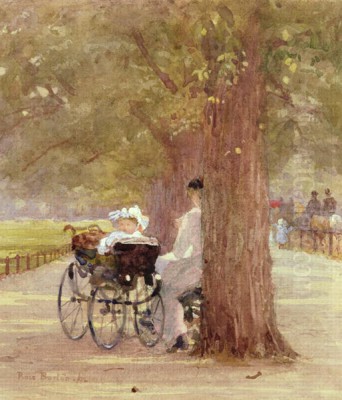
Rose Maynard Barton (1856–1929) stands as a significant, if sometimes overlooked, figure in the annals of late 19th and early 20th-century art. An artist of Irish and British nationality, she carved a distinct niche for herself with her evocative watercolour depictions of urban landscapes, particularly those of London and Dublin. Her ability to capture the fleeting atmospheric conditions of these bustling metropolises, rendered with an Impressionistic sensibility, marks her as a noteworthy practitioner of her time. This exploration delves into the life, work, influences, and legacy of Rose Barton, an artist who translated the ephemeral moods of city life onto paper with remarkable skill and sensitivity.
Early Life and Artistic Awakening
Born on April 21, 1856, in Rochestown, County Tipperary, Ireland, Rose Barton hailed from a prosperous Anglo-Irish family. Her father was Augustine Barton, and her mother was Mary Scott. This affluent background afforded her opportunities for education and travel that were not available to many women of her era. While details of her earliest artistic inclinations are not extensively documented, it is clear that she received private tutoring, a common practice for young ladies of her social standing.
Her formal artistic training began in her late teens. In 1874, at the age of eighteen, Barton travelled to Brussels to study art. This period abroad was crucial, exposing her to continental artistic trends and techniques. She was not alone in this pursuit; she was accompanied by her friend and fellow future artist, Mildred Anne Butler (1858-1941), another prominent Irish painter known for her watercolours of animals, gardens, and rural scenes. The companionship and shared artistic journey with Butler likely provided mutual support and intellectual stimulation.
Formative Training and Influences
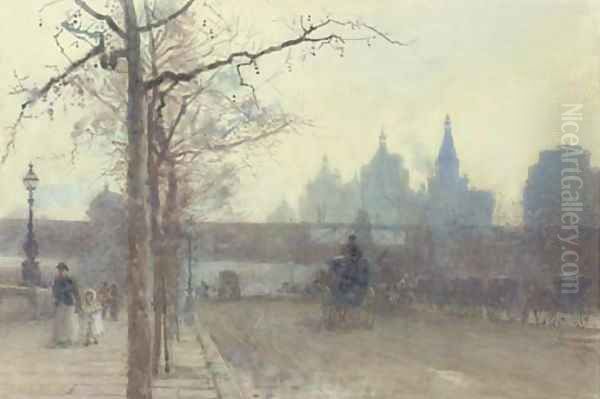
Following her studies in Brussels, Barton's artistic education continued in Paris. The French capital was the undisputed centre of the art world at this time, particularly for avant-garde movements like Impressionism. While in Paris, she is said to have studied alongside Mildred Anne Butler, further solidifying their artistic bond. Though the exact ateliers or masters she studied under in Paris are not always clearly specified in all records, the influence of French art, especially the plein air (open air) approach and the Impressionists' focus on light and atmosphere, became deeply ingrained in her artistic DNA.
Her training was further refined in London under the tutelage of Paul Jacob Naftel (1817–1891). Naftel, a highly respected watercolourist from Guernsey and a member of the Royal Society of Painters in Water Colours, was known for his landscapes. Studying with him would have provided Barton with a strong foundation in traditional watercolour techniques, which she would later adapt to her more Impressionistic style. Some sources also indicate that she received instruction from Henri Gervex (1852–1929) in Paris, a French painter who, while academically trained, often depicted scenes of modern Parisian life, sometimes with a touch of realism and social commentary. Gervex's engagement with contemporary urban subjects might have resonated with Barton's own developing interest in cityscapes.
The confluence of these educational experiences – the academic grounding, the exposure to French Impressionism, and specialized watercolour instruction – equipped Barton with a versatile skill set. She absorbed the Impressionists' fascination with capturing the transient effects of light and weather, their preference for contemporary subjects, and their often looser brushwork, but she channelled these through the delicate and luminous medium of watercolour.
The Urban Muse: London and Dublin
Rose Barton is perhaps best known for her atmospheric cityscapes. She possessed an extraordinary ability to convey the mood and character of London and Dublin, often under specific weather conditions like rain, fog, or the soft glow of twilight and gaslight. Her paintings are not mere topographical records; they are poetic interpretations of urban existence.
London, with its grand architecture, bustling streets, and ever-changing skies, became a recurring subject. She captured the iconic landmarks – the Houses of Parliament, Westminster Abbey, Charing Cross, Piccadilly Circus – but always with an emphasis on the ambient atmosphere. Horse-drawn omnibuses and hansom cabs, figures hurrying along wet pavements, the hazy glow of streetlamps reflected on slick surfaces – these were the elements that brought her London scenes to life. She was particularly adept at rendering the damp, misty quality of London air, a characteristic that many artists, including Claude Monet (1840-1926) during his London sojourns, found captivating.
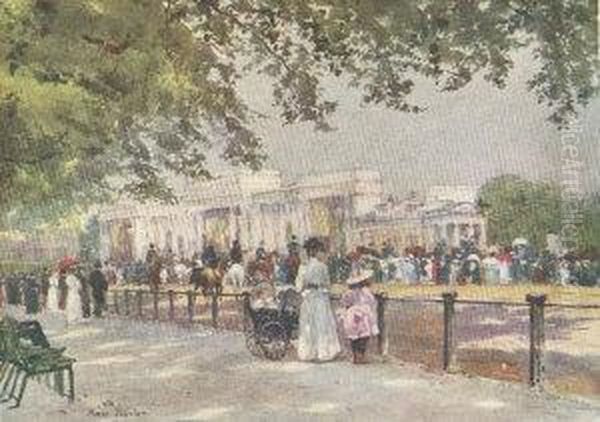
Dublin, her city of birth and early life, also featured prominently in her oeuvre. She painted its familiar streets and buildings with a similar sensitivity to atmosphere and light. Her depictions of Dublin offer a valuable visual record of the city at the turn of the century, imbued with her characteristic Impressionistic charm. Works like College Green, Dublin, with a Shower Passing Off showcase her skill in capturing the rapidly shifting weather patterns of Ireland.
Her approach was akin to that of other Impressionists who found beauty in the everyday life of the city. Artists like Camille Pissarro (1830-1903), with his series of Parisian boulevards seen from above, or Gustave Caillebotte (1848-1894), with his depictions of Haussmannian Paris, shared this interest in the modern urban experience. Barton, however, brought a distinctly gentle, almost ethereal quality to her city views, often emphasizing the romantic rather than the gritty aspects of urban life.
Mastery in Watercolour
Watercolour was Rose Barton's primary medium, and she wielded it with exceptional finesse. The inherent transparency and fluidity of watercolour lent themselves perfectly to her artistic aims: capturing the subtle gradations of light, the softness of fog, the shimmer of rain, and the delicate hues of dawn or dusk. Her technique often involved wet-on-wet washes to create soft, blended backgrounds and atmospheric effects, combined with more precise brushwork for architectural details and figures.
She understood the challenges and strengths of watercolour. Unlike oils, watercolour allows little room for error or extensive reworking. Its luminosity comes from the white of the paper shining through the transparent washes of pigment. Barton exploited this quality to achieve a sense of airiness and light in her paintings. Her palette was often subtle, favouring muted tones that enhanced the atmospheric quality of her scenes, though she could also use brighter touches of colour to highlight specific details, like the red of a postbox or the warm glow from a shop window.
Her skill was recognized by her peers and by prestigious art institutions. Her election as an associate of the Royal Society of Painters in Water Colours (ARWS) in 1893, and later as a full member (RWS) in 1911, were significant accolades, affirming her status as one of the leading watercolourists of her day. The RWS, founded in 1804, was (and remains) a highly esteemed body, and membership was a mark of distinction. Other notable members during or around her time included figures like Sir Edward Poynter (1836-1919) and Hubert von Herkomer (1849-1914), though their styles differed greatly from Barton's.
Key Works and Their Significance

Several of Rose Barton's works stand out as exemplars of her style and thematic concerns.
The Garden of the Royal Hospital, Chelsea (c. 1890s): This work showcases her ability to find picturesque scenes even within an urban context. The gentle rendering of foliage and figures enjoying the tranquility of the garden demonstrates her softer, more idyllic side.
Charing Cross Bridge, London (c. 1896): This painting, depicting the iconic railway bridge, is a quintessential Barton cityscape. It likely captures the bridge shrouded in mist or the smoky haze of industrial London, with light filtering through to create a moody, atmospheric effect. It invites comparison with Monet's famous series of the same bridge, though Barton's interpretation would have its own unique watercolour sensibility.
St Patrick's Cathedral, Dublin: Her depictions of this historic cathedral would have highlighted its Gothic architecture, perhaps set against a dramatic Irish sky or nestled within the surrounding city fabric, showcasing her connection to her Irish heritage.
London in Rain (e.g., Piccadilly in a Shower, A Wet Day, Piccadilly Circus): These works are particularly characteristic, capturing the glistening streets, blurred reflections, and hurried movement of figures under umbrellas. She masterfully conveyed the specific sensory experience of London in the rain, a theme also explored by contemporaries like the British Impressionist Walter Sickert (1860-1942), albeit often with a more sombre or gritty tone.
Nelson's Column on a Wet Night: This subject allowed her to explore the effects of artificial light – gas lamps – on wet surfaces, creating a scene of nocturnal urban poetry. The reflections and the interplay of light and shadow would have been key elements.
These works, and many others like them, demonstrate her consistent vision and technical proficiency. They are not just pretty pictures; they are carefully observed and felt responses to the urban environment, filtered through an Impressionistic lens and rendered with the delicate touch of a master watercolourist.
Exhibitions and Recognition
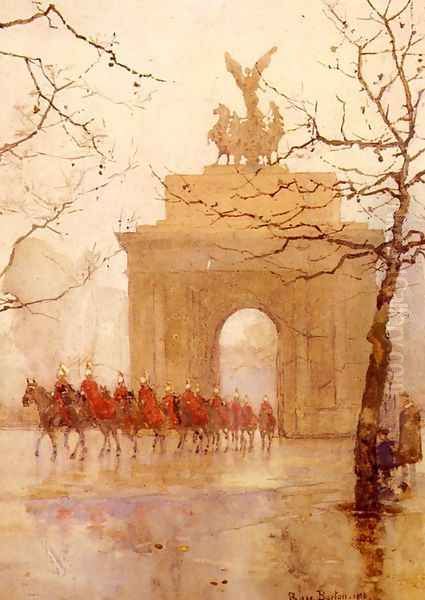
Rose Barton was an active exhibitor throughout her career, showcasing her work in Ireland, England, and potentially further afield. She began exhibiting in Ireland as early as 1878. Her first major exhibition in London was held in 1893 at the Japanese Gallery, where she exhibited alongside George Charles Haité (1855-1924), a versatile artist known for his landscapes, design work, and as president of the London Sketch Club. This joint exhibition would have provided significant exposure in the competitive London art scene.
She subsequently held solo exhibitions at prominent London venues such as the Clifford Gallery and the Chenil Galleries. She also exhibited regularly with key artistic societies. In Ireland, she was associated with the Watercolour Society of Ireland (WCSI), where she served on the committee, and she exhibited at the Royal Hibernian Academy (RHA) in Dublin. Her involvement with the WCSI underscores her commitment to the medium and her standing within the Irish art community, which included artists like Walter Osborne (1859-1903) and Nathaniel Hone the Younger (1831-1917).
In England, beyond her RWS membership, she became a member of the Society of Women Artists (SWA) in 1886. The SWA, founded in 1855 as the Society of Female Artists, provided an important platform for women artists to exhibit and sell their work at a time when opportunities could be limited. Fellow members might have included artists like Laura Herford (1831-1870), the first woman admitted to the Royal Academy Schools, or later figures like Louise Jopling (1843-1933). Barton also exhibited at other London venues like the Dudley Gallery and the Grosvenor Gallery, the latter being known for its association with Aestheticism and more progressive artists.
Her work was generally well-received by critics, who praised her ability to capture atmosphere and her delicate handling of watercolour. She was often compared favourably with her male contemporaries, such as Herbert Menzies Marshall (1841-1913), another artist known for his atmospheric watercolours of London.
A Wider Canvas: Illustration and Publications
Beyond her exhibition pieces, Rose Barton extended her artistic reach into the realm of book illustration. This was a common avenue for artists at the time, providing income and wider dissemination of their work. Her cityscapes were particularly well-suited for illustrating books about urban life and travel.
She produced illustrations for several books published by A & C Black, a prominent publishing house known for its beautifully illustrated travel books. These included:
Familiar London (1904): For this volume, Barton provided numerous watercolour illustrations capturing various facets of London life and its landmarks. Her evocative style perfectly complemented the book's theme.
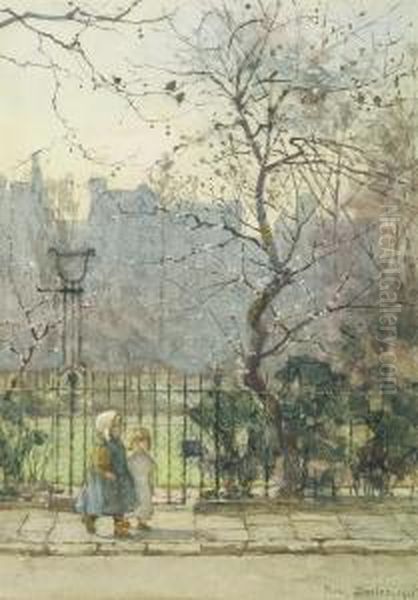
The Ramparts of Empire (1910): This book, which she co-illustrated with Norman Wilkinson (1878-1971), a renowned marine painter and illustrator (and inventor of dazzle camouflage), focused on the British Navy. Barton's contribution likely involved coastal scenes or aspects related to naval bases.
Old and New Dublin (1898, by Frances Gerard, illustrated by Rose Barton): This earlier publication showcased her intimate knowledge of her native city. (Some sources mention a collaboration with "Norman Winkler" on a Dublin book, but "Old and New Dublin" with Frances Gerard is more consistently cited).
She also contributed to other publications, including one simply titled London (1915).
Her work as an illustrator helped to popularize her vision of London and Dublin, making her art accessible to a broader public beyond the gallery-going elite. It also demonstrated the versatility of her talent, adapting her painterly style to the requirements of reproduction.
Contemporaries and Artistic Milieu
Rose Barton operated within a vibrant and evolving artistic milieu. The late Victorian and Edwardian eras saw the flourishing of various artistic styles, from lingering academic traditions to the rise of Impressionism and Post-Impressionism.
In Ireland, she was part of a generation of artists who were increasingly looking to continental Europe for inspiration, while also engaging with Irish subjects. Besides Mildred Anne Butler, other notable Irish artists of her time included John Lavery (1856-1941) and William Orpen (1878-1931), both of whom achieved international fame, though they worked primarily in oils and often in portraiture. Walter Osborne was another key contemporary Irish Impressionist whose work often depicted everyday life and landscapes with a similar sensitivity to light.
In Britain, the New English Art Club (NEAC), founded in 1885, became a significant exhibiting society for artists influenced by French Impressionism, such as Philip Wilson Steer (1860-1942) and the aforementioned Walter Sickert. While Barton may not have been directly affiliated with the NEAC, her work shared some of their aesthetic concerns, particularly the focus on modern life and atmospheric effects.
As a woman artist, Barton was part of a growing number of professional female painters who were challenging the male-dominated art world. Artists like Elizabeth Forbes (née Armstrong, 1859-1912) of the Newlyn School, or the more traditional but highly popular Helen Allingham (1848-1926) with her charming cottage scenes, were her contemporaries. Barton's success in prestigious societies like the RWS was a testament to her talent and perseverance.
Later Years and Enduring Legacy
Rose Barton continued to paint and exhibit into the early 20th century. She divided her time between Ireland and England, maintaining connections in both artistic communities. She never married and dedicated her life to her art.
She passed away on October 10, 1929, at her home in Knightsbridge, London, at the age of 73. Her death marked the end of a prolific and distinguished career.
In the decades following her death, like many women artists of her generation, Rose Barton's name perhaps faded somewhat from mainstream art historical narratives, which often prioritized male artists and oil painting. However, her work has always been appreciated by connoisseurs of watercolour and by those interested in the visual representation of London and Dublin.
In more recent times, there has been a concerted effort by art historians and curators to re-evaluate and give due recognition to the contributions of women artists. Exhibitions focusing on Irish art, British Impressionism, or women painters have increasingly featured Rose Barton's work, bringing it to the attention of new audiences. For instance, her painting Charing Cross Bridge was included in the "NOW YOU SEE US: Women Artists in Britain 1850–2020" exhibition, highlighting her place within the broader story of female artistic achievement.
Her paintings are held in numerous public and private collections, including the National Gallery of Ireland, the Hugh Lane Gallery in Dublin, and the Victoria and Albert Museum in London. Her watercolours continue to be sought after at auction, admired for their technical skill, their evocative power, and their charming depiction of a bygone era.
Rose Barton's legacy lies in her sensitive and atmospheric portrayals of urban life. She was a pioneer in her chosen field, particularly as a woman watercolourist specializing in cityscapes. Her ability to capture the intangible qualities of light, weather, and mood, transforming everyday street scenes into poetic visions, ensures her enduring appeal and her significant place in the history of Irish and British art.
Conclusion
Rose Barton was more than just a skilled painter of city views; she was an artist who possessed a deep empathy for her urban subjects, capturing their essence with a delicate yet confident hand. Her commitment to the watercolour medium, her Impressionistic sensibility, and her focus on the atmospheric nuances of London and Dublin set her apart. From her early training in Brussels and Paris to her established career as a member of the Royal Society of Painters in Water Colours, Barton navigated the art world with talent and determination. Her paintings and illustrations offer a luminous window onto the turn-of-the-century city, preserving its fleeting moments for posterity. As art history continues to broaden its scope and acknowledge the diverse contributions of artists from all backgrounds, Rose Barton's star rightfully shines as a significant interpreter of the urban experience and a master of watercolour.